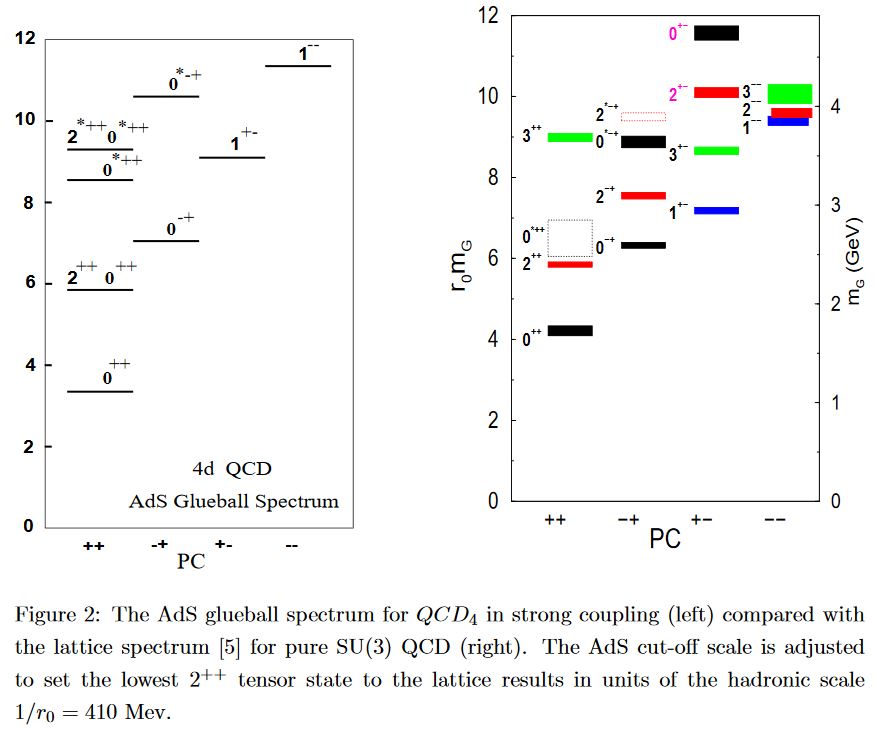nLab glueball
Context
Fields and quanta
fields and particles in particle physics
and in the standard model of particle physics:
matter field fermions (spinors, Dirac fields)
| flavors of fundamental fermions in the standard model of particle physics: | |||
|---|---|---|---|
| generation of fermions | 1st generation | 2nd generation | 3d generation |
| quarks () | |||
| up-type | up quark () | charm quark () | top quark () |
| down-type | down quark () | strange quark () | bottom quark () |
| leptons | |||
| charged | electron | muon | tauon |
| neutral | electron neutrino | muon neutrino | tau neutrino |
| bound states: | |||
| mesons | light mesons: pion () ρ-meson () ω-meson () f1-meson a1-meson | strange-mesons: ϕ-meson (), kaon, K*-meson (, ) eta-meson () charmed heavy mesons: D-meson (, , ) J/ψ-meson () | bottom heavy mesons: B-meson () ϒ-meson () |
| baryons | nucleons: proton neutron |
(also: antiparticles)
hadrons (bound states of the above quarks)
minimally extended supersymmetric standard model
bosinos:
dark matter candidates
Exotica
Contents
Idea
In quantum chromodynamics, in fact already in pure SU(3) Yang-Mills theory, a glueball is a bound state of (just) gluons (a kind of confinement).
Glueballs are hard to detect in experiment but their existence is confirmed by lattice QCD, also by the AdS-QCD correspondence (see there). According to Greensite 11, section 8.5:
The caloron idea is probably the most promising current version of monopole confinement in pure non-abelian gauge theories, but it is basically (in certain gauges) a superposition of monopoles with spherically symmetric abelian fields, and this leads to the same questions raised in connection with monopole Coulomb gases.
Properties
In holographic QCD
In holographic QCD, glueballs are dual to massless scalar fields in the AdS-bulk spacetime (for instance, but not necessarily, the dilaton).
The following graphics shows predictions of glueball spectra from a simple AdS/QCD-model compared to lattice QCD-computations

Apparently the spin structure of type IIA supergravity does resemble the low mass glueball spin splitting. (Brower-Mathur-Tan 00, p. 22)
References
General
The first article discussing glueballs is apparently
- Harald Fritzsch, Peter Minkowski, Ψ-resonances, gluons and the Zweig rule, Nuov. Cim. A, 1975,30: 393 (doi:10.1007/BF02730295)
Review:
-
Vincent Mathieu, The Physics of Glueballs, Zakopane, February 2009 (pdf, pdf)
-
Jeff Greensite, An Introduction to the Confinement Problem, Lecture Notes in Physics, Volume 821, 2011 (doi:10.1007/978-3-642-14382-3)
See also
- Wikipedia, Glueball
In holographic QCD
Discussion of glueballs in holographic QCD (AdS/QCD):
-
Richard C. Brower, Samir Mathur, Chung-I Tan, Glueball Spectrum for QCD from AdS Supergravity Duality, Nucl. Phys. B587:249-276, 2000 (arXiv:hep-th/0003115)
-
Alex S. Miranda, C. A. Ballon Bayona, Henrique Boschi-Filho, Nelson R. F. Braga, Glueballs at finite temperature from AdS/QCD, Nucl. Phys. Proc. Suppl. 199 (2010) 107-112 [arXiv:0910.4319, doi:10.1016/j.nuclphysbps.2010.02.013]
-
Xue-Feng Li, Ailin Zhang, Scalar glueball in a soft-wall model of AdS/QCD, Chinese Physics C, Volume 38, Number 1 (arXiv:1309.7154)
-
Cornélio Rodrigues Filho, Glueballs in the Klebanov-Strassler Theory: Pseudoscalars vs Scalars (arXiv:2011.12689)
Last revised on July 1, 2024 at 16:41:12. See the history of this page for a list of all contributions to it.